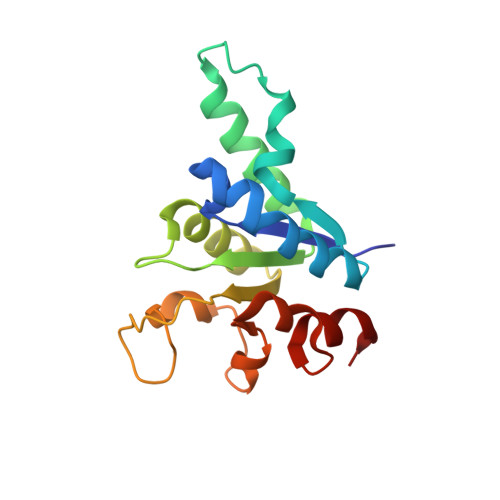Snapshots of the Reaction Coordinate of a Thermophilic 2'-Deoxyribonucleoside/ribonucleoside Transferase.
Tang, P., Harding, C.J., Dickson, A.L., da Silva, R.G., Harrison, D.J., Czekster, C.M.(2024) ACS Catal 14: 3090-3102
- PubMed: 38449528
- DOI: https://doi.org/10.1021/acscatal.3c06260
- Primary Citation of Related Structures:
8PQP, 8PQQ, 8PQR, 8PQS, 8PQT, 8QC0, 8RH3 - PubMed Abstract:
Nucleosides are ubiquitous to life and are required for the synthesis of DNA, RNA, and other molecules crucial for cell survival. Despite the notoriously difficult organic synthesis of nucleosides, 2'-deoxynucleoside analogues can interfere with natural DNA replication and repair and are successfully employed as anticancer, antiviral, and antimicrobial compounds. Nucleoside 2'-deoxyribosyltransferase (dNDT) enzymes catalyze transglycosylation via a covalent 2'-deoxyribosylated enzyme intermediate with retention of configuration, having applications in the biocatalytic synthesis of 2'-deoxynucleoside analogues in a single step. Here, we characterize the structure and function of a thermophilic dNDT, the protein from Chroococcidiopsis thermalis ( Ct NDT). We combined enzyme kinetics with structural and biophysical studies to dissect mechanistic features in the reaction coordinate, leading to product formation. Bell-shaped pH-rate profiles demonstrate activity in a broad pH range of 5.5-9.5, with two very distinct p K a values. A pronounced viscosity effect on the turnover rate indicates a diffusional step, likely product (nucleobase1) release, to be rate-limiting. Temperature studies revealed an extremely curved profile, suggesting a large negative activation heat capacity. We trapped a 2'-fluoro-2'-deoxyarabinosyl-enzyme intermediate by mass spectrometry and determined high-resolution structures of the protein in its unliganded, substrate-bound, ribosylated, 2'-difluoro-2'-deoxyribosylated, and in complex with probable transition-state analogues. We reveal key features underlying (2'-deoxy)ribonucleoside selection, as Ct NDT can also use ribonucleosides as substrates, albeit with a lower efficiency. Ribonucleosides are the building blocks of RNA and other key intracellular metabolites participating in energy and metabolism, expanding the scope of use of Ct NDT in biocatalysis.
Organizational Affiliation:
School of Biology, Biomedical Sciences Research Complex, University of St Andrews, St Andrews, Fife KY16 9ST, United Kingdom.















